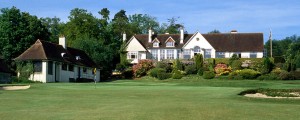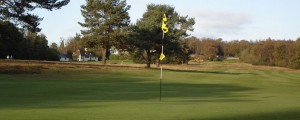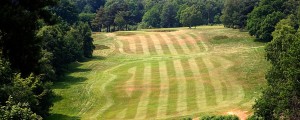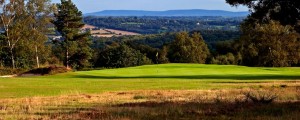Crowborough Beacon Golf Club Course Review
Enjoying the most enviable of positions close to the highest point in East Sussex, views from Crowborough Beacon Golf Club take in much of the southern half of the county and the glorious South Downs. But this club offers far more than just a view, boasting one of the best heathland golf courses in the region, a classic Dr. Alister MacKenzie design dating back to 1895.  At just over 6,300yards from the tips the course today would probably be described as of traditional length, but that is by no means a criticism. The strength of this course, and with it the pleasure of playing it, lies in finding the right positions off the tee, avoiding the cleverly placed heather-edged bunkers, and staying out of the penal rough. With those negotiated, the small but deceptively undulating greens ensure that the course offers a stern test without beating you into submission.
At just over 6,300yards from the tips the course today would probably be described as of traditional length, but that is by no means a criticism. The strength of this course, and with it the pleasure of playing it, lies in finding the right positions off the tee, avoiding the cleverly placed heather-edged bunkers, and staying out of the penal rough. With those negotiated, the small but deceptively undulating greens ensure that the course offers a stern test without beating you into submission.
For my part, Crowborough Beacon offers what I think the vast majority of golfers seek from a day’s golf: a pretty course that’s testing but not overly demanding so you can just get on with enjoying your game, and a welcome that makes you feel comfortable. Add in the panoramic views that would be the envy of most courses in the country and here is a set-up that is hard to beat.
Front Nine
Descending from the grandly positioned clubhouse, it’s easy to stride down the opening holes at Crowborough Beacon with a sense of vigour and confidence. And what finer feeling to have for an opening drive! But be warned – without due care and attention, ambitions of a good score might be quickly dashed.
 From the opening tee, the drop in elevation makes for an attractive and inviting tee shot, with the slope shortening (visually, at least) what is a trickier opening hole than first impressions would have you believe. It’s worth looking back to the tee once you reach the green, as this is where the change in elevation (a consistent theme throughout the course) is first evident. The second is a sharp dogleg right that also descends gradually and presents the first choice of the round – a blind tee shot over the corner or a conservative tee shot to set up a lengthy approach. Either way, one of the two shots will test you. Looks can be deceiving – this isn’t the easiest of starts.
From the opening tee, the drop in elevation makes for an attractive and inviting tee shot, with the slope shortening (visually, at least) what is a trickier opening hole than first impressions would have you believe. It’s worth looking back to the tee once you reach the green, as this is where the change in elevation (a consistent theme throughout the course) is first evident. The second is a sharp dogleg right that also descends gradually and presents the first choice of the round – a blind tee shot over the corner or a conservative tee shot to set up a lengthy approach. Either way, one of the two shots will test you. Looks can be deceiving – this isn’t the easiest of starts.
The par 3 third, as with all those at Crowborough Beacon, adds weight to the old argument that the best par 3s aren’t necessarily the longest. Short, uphill, and delightfully pretty, for the majority this won’t require more than a short iron, but to be in with a realistic birdie chance you’ll want to leave an uphill putt. Precision is the name of the game here.
Perhaps my favourite hole on the course was the short par 4 fourth. The slightly raised tee provides a lovely viewing point and the heather-framed fairway slopes gently from left to right, down towards the green. The hole narrows as it nears the putting surface and rewards only the most precise of approach shots with the chance of a birdie.
 The fifth is a par 4 toughened by the uncomfortable stance you’re likely to have for your blind approach played from a rising fairway to a green that rests over the brow of the hill. If your breath hasn’t been taken away by the time you reach the green, it surely will when standing on the sixth tee, a wonderful par 3 with cavernous danger lurking all down the left hand side. It’s a psychologically demanding hole as much as anything else, with a bail-out area to the right that proves inevitably too inviting! Trouble avoided, perhaps, but if this is where you have played to, you’ll still do well to avoid spoiling your card as a you’ll be left with a devilishly difficult ‘up and down’.
The fifth is a par 4 toughened by the uncomfortable stance you’re likely to have for your blind approach played from a rising fairway to a green that rests over the brow of the hill. If your breath hasn’t been taken away by the time you reach the green, it surely will when standing on the sixth tee, a wonderful par 3 with cavernous danger lurking all down the left hand side. It’s a psychologically demanding hole as much as anything else, with a bail-out area to the right that proves inevitably too inviting! Trouble avoided, perhaps, but if this is where you have played to, you’ll still do well to avoid spoiling your card as a you’ll be left with a devilishly difficult ‘up and down’.
The first par 5 arrives at the seventh and, depending on the wind, which can inevitably blow strongly given your exposure to the elements here, this is likely to be proper three-shotter. The green is also tightly protected by thick rough and a lurking bunker that make this no easy hole to pick up a shot.
The eighth is a very straight and lean par 4, played to another deceptively sloping green, whilst the ninth hole, a short dogleg to the left, marks the point where positional play starts to become paramount. There are several holes from this point on the course on where temptation is to pull the headcover from your longest club, but in reality at holes nine, eleven, twelve, fifteen, and sixteen, the wise decision is to rein yourself in if you are to give yourself the best chance to score well.
Back Nine
The par 5 tenth requires a particularly accurate drive between the trees before the hole turns to the right and climbs gently to the green. Anything off the fairway with the first couple of shots will make hitting this green in regulation a particularly tall order.
The lovely eleventh threads through the trees and patches of heather and if you can hit the conservative shot to the middle of the fairway, the reward is an attractive pitch played between the neatly placed bunkers that guard the green. The twelfth is another particular favourite, as this tough par 4 prohibits an aggressive tee shot, instead forcing you to play the second shot with a long club in hand. It’s a wonderful example of how a shorter golf course can still demand that players use every club in the bag through the course of a round.
The thirteenth is slightly unusual in being a short par 3 with a fairly large green. Its protection comes from the flag placements on the putting surface – simply hitting the green here certainly isn’t enough to guarantee par.
 The last par 5 on the course is the fourteenth, where a subtle camber in the fairway means that accuracy is again at a premium. It’s probably the most inviting par 5 on the course, but equally the one most heavily influenced by the wind. The green sits lower than the fairway and runs away from the direction of the approach shot, so given the springy turf, a links-style ‘bump and run’ might be the clever option.
The last par 5 on the course is the fourteenth, where a subtle camber in the fairway means that accuracy is again at a premium. It’s probably the most inviting par 5 on the course, but equally the one most heavily influenced by the wind. The green sits lower than the fairway and runs away from the direction of the approach shot, so given the springy turf, a links-style ‘bump and run’ might be the clever option.
The difficulty on the par 4 fifteenth is presented by a fairway that slopes significantly from left to right. Predictably, this feeds most tee shots down to the lower right hand side of the fairway, and holding the fairway at all is a challenge in itself. That negotiated, the right handed golfer will still be faced with a testing approach played with the ball below the feet, making the green a tricky one to find.
Much like the eleventh, the sixteenth is a hole best played with prudence. A solid iron off the tee will leave nothing more than a mid length pitch to a raised green. Throw caution to the wind on the tee and, more than likely, you can kiss goodbye to the opportunity of a birdie, too. The last par 3 comes at the seventeenth, a short but significantly uphill hole that is also protected by a gentle slope in the green, before the final climb towards the clubhouse begins.
Remembering the first hole, which runs parallel to the eighteenth, will serve you well playing the last, as this testing right-to-left dogleg plays longer than its yardage, courtesy of the change in elevation. An extra club or two to be advised! This is a truly championship standard finish to a lovely golf course – a final fling with a driver tight up the left half of the fairway, followed by a mid length iron to a green that slopes considerably from back to front. I am sure anyone requiring a par up the last will be mightily relieved to walk off with a four.
After an uphill finish like that, the clubhouse bar beckons more than most. While many golf clubs benefit from a terrace or a bar with charming views to the course, I doubt many compare to the vistas of Crowborough Beacon. Here you can enjoy a drink above a golf course that stretches out between you and the South Downs in the distance. One of the wonderful things about golf is that true sense of satisfaction that can come from surveying a course you’ve just played from on high, drink in hand, irrespective of whether it or you came out on top.
And in many ways, that is the measure of golf at Crowborough Beacon. No matter how you play, you’ll always enjoy your round.